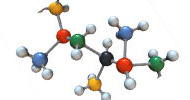
 Categories
Categories  Molecular Biology
Molecular Biology


HPLC peptide mapping analysis integrates the separation capabilities of high-performance liquid chromatography (HPLC) with the qualitative and quantitative...

The N-terminal sequence is closely related to the function and stability of proteins. The analysis of the N-terminal sequence of proteins can determine the...

Glycosylation has significant impacts on the efficacy, stability, and immunogenicity of biopharmaceuticals. Among these, the oligosaccharide spectrum and...

Monosaccharides are the simplest form of sugar molecules and cannot be further hydrolyzed into smaller units. Monosaccharide composition profiling refers to...

N-glycosylation is a common form of glycosylation modification in eukaryotes. Under the catalytic action of glycosyltransferases, oligosaccharide chains form...

Glycosylation is a common post-translational modification (PTM) of proteins, which significantly affects the function and stability of proteins. Glycosylated...

A key step in drug discovery is target identification-identifying "druggable" biological targets. After a target is identified, it must be validated to...

Disulfide bonds are a crucial structural element in proteins, formed by the sulfur atoms from cysteine amino acid residues under oxidative conditions. These...

In eukaryotic cells, the 3' end of mRNA is often extended with a poly(A) tail, a sequence of purine nucleotides. The poly(A) tail is a long chain of...

Thermal stability is defined as the ability of a substance to resist irreversible chemical or physical changes at elevated temperatures, typically by...

Molecular size variation critically influences the properties of biomacromolecules such as proteins, antibodies, and peptides, especially in the realms of...

Aggregation or fragmentation of protein molecules primarily causes variations in molecular size, impacting their biological activity, stability, and their...

The determination of protein content is a fundamental task in protein-related bioscience, medical research, and biopharmaceutical fields. Despite various...

Glycosylation is an important post-translational modification of proteins. Based on the different linkage modes between the glycan and peptide chains,...

Fourier transform infrared (FT-IR) spectroscopy is a powerful technique for obtaining the infrared spectra of absorption/emission in solids, liquids, or...

MALDI-TOF analysis of peptide mixtures is capable of tolerating moderate amounts of buffers and salts, with peptide fragments predominantly producing singly...

Protein sample identification generally only uses Trypsin for protein digestion, with peptide coverage identified around 60%. To obtain the complete sequence...

Sialic acid, a carbohydrate prevalent throughout nature, primarily composes the glycoproteins and glycolipids of animal cell membranes and secretions, as...

Host cell proteins (HCP) content analysis, a critical quality control measure, is essential for determining and quantifying the content of HCP in the final...

The isoelectric point (pI) of a protein is closely related to its amino acid sequence and three-dimensional structure. The pI of a specific protein is fixed,...